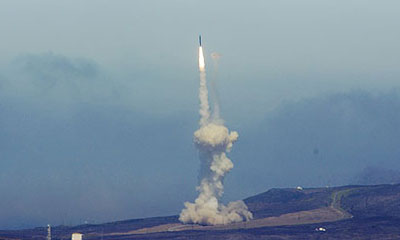The North Koreans are still dangerousby Taylor Dinerman
|
| North Korea can be expected to try and recover from the failed Taepodong 2 test by trying something even more attention-getting than a simple test launch. |
That is not the end of it, by a long shot. Missile development programs are, as we all know, full of failures and disappointments. A dictator such as Kim Jong Il is not going to give up his dream of being able to hit the US with a nuclear missile just because of a failed test. If he can starve hundred of thousands—if not millions—of his subjects in order to pay for a comprehensive nuclear and missile development program, why should this setback stop him?
Other dictators whose weapons programs experienced failures or were disrupted have often been inspired to continue their efforts with ever greater intensity. The best recent example is the way Saddam Hussein continued his nuclear weapons program after the Israelis knocked out his French-supplied reactor in 1981. North Korea can be expected to try and recover from the failed Taepodong 2 test by trying something even more attention-getting than a simple test launch.
The so-called “War of the Cities” that began in 1985 during the Iran-Iraq War gave the North Korean missile program the impetus it needed to move from an underfinanced, but important, part of the Communist dictatorship’s program to become their second greatest military priority, behind their nuclear weapons program.
Between 1985 and 1988 the Iranians found that Scud missiles in various forms were the only reliable way they had to strike Baghdad and other targets deep inside Iraq. Their once-huge air force had been reduced by the US embargo to only a few planes, and those were kept for only the most important missions. Scuds, on the other hand, did not need expensively-trained pilots who might not be politically reliable. The Iraqis and the Iranians found that ballistic missiles made excellent terror weapons. According to one source, in 1988 the Tehran regime fired 77 Hwasong 5 (Scud B) type missiles at Iraq’s major cities.
While Iraq was able to get Scuds from the USSR and then modify them in-country, the Iranians needed to turn elsewhere. While they got a few from Libya, for the most part they got their missiles from North Korea. From Pyongyang’s point of view the most important thing about Iran’s missile program was that the oil-rich regime in Tehran paid for these weapons in hard currency.
| It could be that soon, any nation with enough money will be able to buy weapons from North Korea that will allow it to threaten any other nation on Earth. |
Last week’s tests seem to have included a variety of their ballistic missile types, including the previously-mentioned Hwasong and the longer range No-dong. What we may have seen on July 4th is not so much a series of operational and development tests, but something more like a live fire sales demonstration. The North Koreans have sold ballistic missiles, missile parts, and technology to Libya, Egypt, Sudan, Syria, Iraq, Yemen, Iran, and Pakistan. More than any other single country, they have been proliferating ballistic missile technology to just about anyone who will pay. Hugo Chavez’s planned visit to Pyongyang might soon result in Venezuela being added to the list. It is also worth noting that Egypt and Pakistan both receive significant sums of aid money from both the US and Japan. One hopes that people in the US State Department and in Japan’s Ministry of Foreign Affairs are going to be asking some hard questions.
According to the Federation of American Scientists (FAS) the Taepodong 2’s first stage has a burn time of between 120 and 130 seconds, which means that it failed about halfway though its run. The same source estimates that the thrust for this stage at approximately 1,000 kilonewtons, very roughly comparable to that of the US Minuteman ICBMs and much less than that of early American and Soviet liquid-fueled ICBMs. If the FAS figures are accurate then the Taepodong 2 has the capacity to become, after a lot more work and a lot more testing, the first exportable ICBM.
It could be that soon, any nation with enough money will be able to buy weapons from North Korea that will allow it to threaten any other nation on Earth with, at least, the sort of harassing and occasionally deadly bombardment that the Palestinians are now inflicting on the Israelis. For example, the Democratic Republic of the Congo has long-standing grievances against Belgium; a few Taepodongs could allow them to fire off one or two of these every month just to remind Belgium of their complaints. The same thing goes for Algeria and France or Zimbabwe and Britain. A Third World dictator could gain a lot of cheap nationalist legitimacy from launching a few pinprick Taepodong attacks on faraway former colonial states.
If the Israelis are now expected by the so-called international community not to overreact to a few Kassams landing on their southern towns, then the same restraint will be expected of other nations when Taepodongs start falling on them. The North Korean regime could find it very profitable to encourage a new age of long-range revenge attacks on Western nations whose capacity to strike back is limited by their adherence to treaties and to a belief in “civilized” forms of warfare.
Against these types of attacks, current fairly expensive missile defense systems are of limited use. An impoverished Third World state could get almost as much political satisfaction from forcing a Western nation to use its costly interceptors against a relatively cheap Taepodong ICBM as from actually landing a warhead on an enemy target. We could be entering an age of globalized, intercontinental, low-intensity combat. Is anyone prepared?
